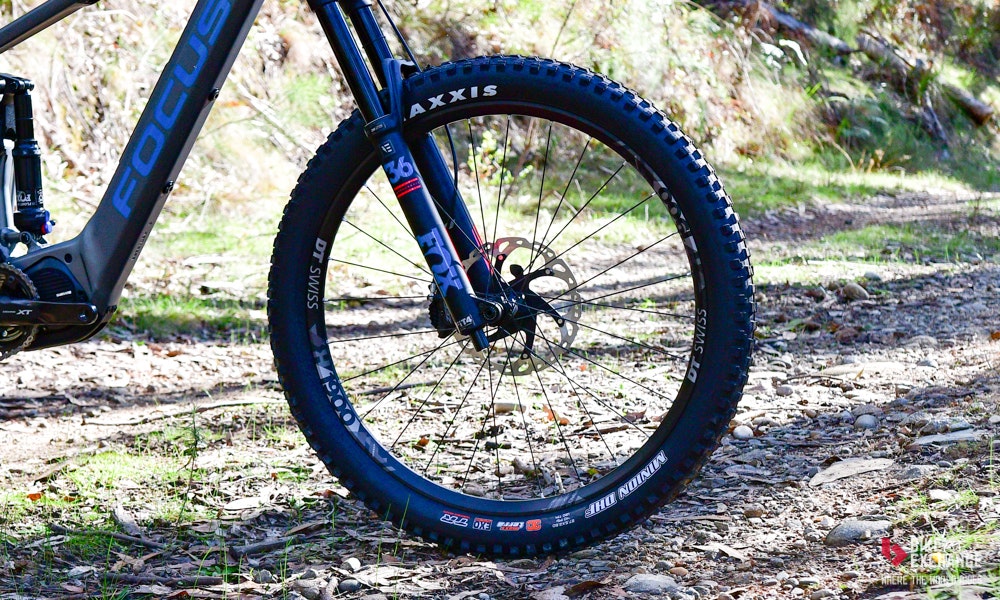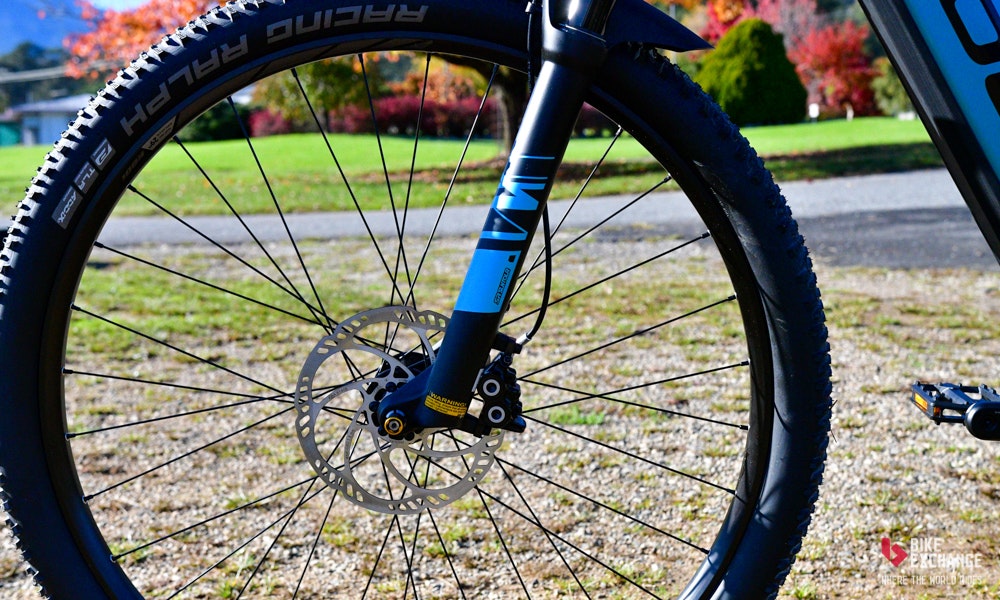As the single fastest growing e-bike category on the market, electric mountain bikes, known as E-MTB's are becoming an increasingly common sight in mountain bike parks and on trails across the country. However, as is the case with regular mountain bikes, several different subcategories exist, each designed for different terrain, ride styles and ability levels.
In this article, we got our hands on the three most popular types; Hardtail, Trail and Enduro E-MTB's and set about putting them through their paces, all in an effort to simply explain what to expect from each different type, how they're different, the kind of terrain they're designed for.
- Related Reading: The Ultimate E-Bike Buyer's Guide
E-MTB'S Explained

More than just a mountain bike with a motor attached, E-MTB's have broken away from their analogue siblings into a category of their own. Outfitted with robust, temperature efficient frames; e-bike specific suspension and drivetrain componentry; and a slack and stable geometry, E-MTB's are equal parts performance and control.
Where traditional mountain bikes struggle to balance the demands of descending with the need to climb back out, E-MTBs can make both a breeze. This is the biggest attraction to these premium assisted steeds, and you can have all the descending confidence and control of an Enduro mountain bike, but in a package that laughs at all but the most daunting of climbs.

Framesets will typically be manufactured from aluminium; however, carbon fibre is beginning to trickle down from the extreme top end to more affordable prices. Both carbon and aluminium are favoured thanks to their ability to be moulded and shaped into a multitude of different frame shapes and designs, perfect for implementing battery systems into the frame designs.

Drive units fitted to E-MTB's will typically be the most powerful available, within legal road limits of course. Key industry players such as Bosch, Shimano, Brose and Yamaha have developed E-MTB specific drive systems, optimised for trail use. These E-MTB units will typically include a range of different assistance levels, ranging from low-output, aiding in downhill flow; to punchy high-output modes, helping riders scamper up steep pinches with ease.
This increased output from the drive systems typically sees E-MTB's outfitted with e-bike specific componentry. High-stress components such as the chain, cassette and crankset generally are reinforced, as are the hydraulic disc braking systems.

Laced with additional spokes and reinforced rims to deal with the extra heft and braking forces required, E-MTB wheels focus on durability rather than weight savings. Big bag 2.3" + tubeless tyres are also commonplace on E-MTB's thanks to the additional traction and grip provided.
- Related Reading: The Best 2019 E-MTB’s
The Categories

Both Hardtail and Dual-Suspension E-MTB's are available, however, where budget allows, the latter is generally the preferred option due to the increased versatility provided by the additional suspension travel. For approximate costs, Hardtails are typically priced from AU$3,000 to AU$5,500~, whereas a Dual-Suspension bike will likely set buyers back above AU$5,000.
For the sake of this comparison, we've opted for a fleet of Focus E-MTB's, with the Jarifa2 6.8 Hardtail, Jam2 6.9 Dual-Suspension Trail, and Sam2 6.9 Dual-Suspension Enduro. The test bikes are equipped with a mix of Shimano E8000 and Bosch Performance CX E-MTB specific drive units which offer increased output for tackling technical terrain. Batteries are similar across the board, with between 400Wh and 500Wh battery systems provided, suitable for around 40-70km of assisted riding on the trail.
The Dual-Suspension models each feature e-bike specific suspension front and rear, with all models scoring a Shimano Deore XT drivetrain and dropper seatposts as standard. All three bikes are offered in 1x configuration, with wide range 11-46 cassettes fitted out back. Rolling stock is a mixed affair with the Sam and Jam rolling on DT Swiss wheels wrapped in grippy Maxxis tubeless rubber, whereas the Jarifa makes do with a Novatech wheelset wrapped in Schwalbe tyres.
Hardtail

The most attainable, and likely the first foray into E-MTB riding many riders will experience, Hardtail E-MTB's are designed to balance a wallet-friendly price point, with user-friendly usability. While the lack of rear suspension limits the terrain and trails that hardtails will flourish on, there's still no shortage of singletrack to ride aboard a hardtail. These bikes are often most at home on fire roads, smoother XC trails and gravel tracks with punchy climbs.

Often kitted out with between 100-150mm of travel at the fork, both leisurely XC based hardtails and burlier Trail hardtail E-MTB's exist, the latter more trail worthy thanks to the increased travel and wider grippier tyres on offer.

Compared to its analogue counterparts, the geometry of a hardtail E-MTB will likely be much slacker by comparison. This means that the headtube angle will be less steep than say an XC machine, with both the wheelbase and trail often longer as a result. This is mostly due to the increased weight that comes with the addition of the battery system and drive unit. Moving to the rear of the bike and semi-steep seat tube angles and shorter chainstays balance pedalling efficiency and acceleration when putting the power down.

So if you're looking at balancing leisurely rides with the family, and hitting the odd XC trail when the opportunity presents, a Hardtail E-MTB is worthy of consideration. However, if you're looking to explore a vast trail network featuring more technical terrain, other bikes in this guide may serve as a better tool.
Trail/All-Mountain

Whereas a traditional Trail bike will offer between 120-150mm of travel, E-MTB trail bikes will blur the lines between a trail bike and an all-mountain bike, offering increased travel, wider tyres and stronger components than their analogue cousins.
The All Mountain category overlaps Trail and Enduro bikes, so as such, is filled with bikes that thrive on backcountry trails, uncharted terrain in the wilderness, and more technical mountain bike park runs. So with a wide variety of territory to cover, All Mountain bikes are designed to be versatile as a result.

With suspension travel ranging from 140-160mm front and rear, this makes these bikes more adept at handling technical features, whereas a similarly steep seat tube angle of 74-75º aids in the rider putting the power down up steep pinches. Chainstays around 420-425mm in length aid in the more agile handling characteristics compared to longer travel bikes.
Expect headtube angles to be around 1º slacker and combined a 50-100mm increase in wheelbase compared to a traditional trail bike, E-MTB's in this category are also likely to feel much more stable at speed. Further aiding in steadiness on the trail, the mid-mounted pedelec drive unit will typically be mounted down slightly lower than where the bottom bracket is located on a traditional Trail bike, balancing handling and ground clearance on technical terrain.

The reach will also be longer compared to a traditional Trail bike, placing the rider in an extended position on the bike, increasing control when attacking the trail. Aluminium is the frameset material of choice for the rear swingarm and frame; however, lightweight carbon frames are also available as costs increase.
Looking at componentry, and the build kit will typically mirror that found on a traditional Trail bike, save for stiffer cranks, wheels and brakes to deal with the increased braking forces and weight on board. Dropper seatposts are typically included as standard, a must for riders wanting to balance downhill manoeuvrability with seated climbing ability.

So if you're looking for an assisted bike that is at home on a wide range of trails, barring extremes at either end of the spectrum, a Trail/All Mountain E-MTB may just be the right pick for you. However, if you're looking to self-shuttle downhill runs, huck some jumps, rip some berms or your local trails demand increased travel, the more extended travel Enduro bike listen below may be a better fit.
Enduro

With suspension travel ranging from 160-180mm, Enduro E-MTB bikes are much burlier than their shorter travel counterparts. This makes them much better suited to big drops, uncharted terrain and gnarlier trails.

Tyre widths will typically range from 2.3" to 2.8" with wheelsets almost exclusively set up tubeless. Tubeless tyres are favoured in mountain biking thanks to the lower pressures they allow, increasing the contact patch and allowing the more aggressive tyres to grip the trail more efficiently. Boost spacing (wider axle widths front and rear) is also in play on most, if not all, Enduro bikes on the market. Boost spacing allows for manufacturers to offset the drivetrain slightly for a straighter chainline, and the ability to run wider tyres than a frame would typically allow.

Moving to the contact points and bars over 750mm wide are commonplace, as are super short stems, which allow for more direct handling on the trail. Dropper seatposts are also essential, allowing a rider to quickly move and shift their weight around the bike on technical descents. Stopping power will also be beefed up, with more powerful four-piston brakes becoming commonplace on Enduro bikes. When mated with 180-203mm rotors, these provide an extraordinary amount of braking force that is both easily modulated yet commands respect on the trail.

The wheelbase will be considerably longer than a trail E-MTB and marginally more extended than a traditional Enduro bike thanks to a more relaxed headtube angle of around 65º. A longer reach figure allows the rider to get lower on technical descents whereas the powerful drive system combined with a trail bike like seat tube angle ensures that riders can climb the up trail with ease for another lap.

So if you're looking for a steed that'll run laps all day, eat up downhill tracks and take big air and big hits, an Enduro E-MTB will be right up your alley. However, if it's more sedate family trails or the versatility you're after, a Hardtail or Trail E-MTB may be a better fit.
Thanks to Focus Australia for providing the product for this guide.
For more on the different mountain bike categories, check out our XC vs Trail vs Enduro Bikes Explained feature, or shop all E-MTB’s right here, at BikeExchange.




